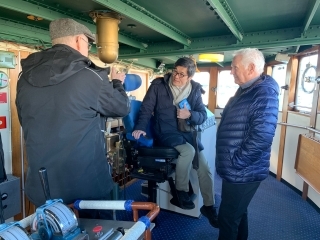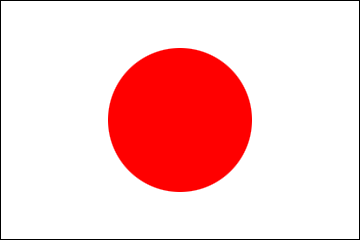From Ambassador (Icelandic Coast Guard)
2022/4/23



Somewhat unusual for an independent country, Iceland does not have a military force of its own.
In the period under Danish rule, it was the Danish King, who kept control of its military affair and defense matters. When Germany occupied Denmark during the Second World War, that event eventually lead Iceland to declare independence in 1944. In 1940, British military forces came to occupy Iceland, and later Americans. That was, among other things, to prevent potential attacks on Iceland from German forces. As such, the Icelanders never had to pick up weapons and fight over its independence, as Americans did in the past. Hence, Iceland did not have to build up its own military forces of its own.
Technically, though, a well-qualified law enforcement agency, the Icelandic Coast Guard, is partly responsible for its national security.
An offshore patrol vessel “Óðinn” is one of the Coast Guard ship which had long been playing such role. This gun boat, which was named after the main God in Norse mythology, was inaugurated in 1960 and retired in 2006. Its retirement was missed by many. Now Óðinn welcomes visitors as a museum ship under the Icelandic Coast Guard‘s management.
Luckily, I was invited to visit Óðinn a few days ago.
With all due respect, this ship is not a grand boat. That was no comparison, for example, with a British Royal Navy aircraft carrier, HMS Prince of Wales, which I recently had a chance to pay a visit. The only weapon which Óðinn was equipped with was an old gun installed at the bow of the vessel, and it was used during the Boer War by the British Army. It came as a surprise for me to learn this, because I was imagining a fully weaponized vessel. Come to think of it, since the Coast Guard’s vessel’s main responsibilities are to patrol and crackdown on illegal fishing in Icelandic waters, rescue operation at sea and so forth, rather than fighting with enemies, it all makes sense. For Icelandic fishermen who may have to operate in a bad weather, I am sure that the presence of this vessel must have been very reassuring.
I find it a little ironic that the Icelandic Coast Guard, with Óðinn as its flag ship, became world famous for its battle against British Royal Navy in so-called “Cod War”. As Iceland unilaterally expanded its territorial waters and exclusive fishing zones from 50s to the 70s, the Icelandic Coast Guard tried to prevent British fishing vessels from operating in the waters to catch cods. That led to serious clashes with the British Navy, which claimed that the Icelandic action is against the Law of the Sea, and tried to prevent the capture of their fishing vessels.
Guðmundur, who kindly showed us around the ship that day, was a former parliamentarian and has been devoting his time to preserve Óðinn as a museum ship after his retirement. He told me smiling that the today’s younger generation in Britain knows nothing about the Cod Wars, and went on to say that wars were something to be regretted, and no matter what the circumstances, it should not have happened.
Without bragging about the fact that the Icelandic Coast Guard “won” the War in the end, Guðmundur calmly talked about the misery of war, and I was deeply moved by his words.
In coming June, Óðinn will set sail for the first time in a long time since her retirement. The new mast standing at the bow was, in fact, manufactured and donated by a Japanese ship builder. But that is another story for another time.
In the period under Danish rule, it was the Danish King, who kept control of its military affair and defense matters. When Germany occupied Denmark during the Second World War, that event eventually lead Iceland to declare independence in 1944. In 1940, British military forces came to occupy Iceland, and later Americans. That was, among other things, to prevent potential attacks on Iceland from German forces. As such, the Icelanders never had to pick up weapons and fight over its independence, as Americans did in the past. Hence, Iceland did not have to build up its own military forces of its own.
Technically, though, a well-qualified law enforcement agency, the Icelandic Coast Guard, is partly responsible for its national security.
An offshore patrol vessel “Óðinn” is one of the Coast Guard ship which had long been playing such role. This gun boat, which was named after the main God in Norse mythology, was inaugurated in 1960 and retired in 2006. Its retirement was missed by many. Now Óðinn welcomes visitors as a museum ship under the Icelandic Coast Guard‘s management.
Luckily, I was invited to visit Óðinn a few days ago.
With all due respect, this ship is not a grand boat. That was no comparison, for example, with a British Royal Navy aircraft carrier, HMS Prince of Wales, which I recently had a chance to pay a visit. The only weapon which Óðinn was equipped with was an old gun installed at the bow of the vessel, and it was used during the Boer War by the British Army. It came as a surprise for me to learn this, because I was imagining a fully weaponized vessel. Come to think of it, since the Coast Guard’s vessel’s main responsibilities are to patrol and crackdown on illegal fishing in Icelandic waters, rescue operation at sea and so forth, rather than fighting with enemies, it all makes sense. For Icelandic fishermen who may have to operate in a bad weather, I am sure that the presence of this vessel must have been very reassuring.
I find it a little ironic that the Icelandic Coast Guard, with Óðinn as its flag ship, became world famous for its battle against British Royal Navy in so-called “Cod War”. As Iceland unilaterally expanded its territorial waters and exclusive fishing zones from 50s to the 70s, the Icelandic Coast Guard tried to prevent British fishing vessels from operating in the waters to catch cods. That led to serious clashes with the British Navy, which claimed that the Icelandic action is against the Law of the Sea, and tried to prevent the capture of their fishing vessels.
Guðmundur, who kindly showed us around the ship that day, was a former parliamentarian and has been devoting his time to preserve Óðinn as a museum ship after his retirement. He told me smiling that the today’s younger generation in Britain knows nothing about the Cod Wars, and went on to say that wars were something to be regretted, and no matter what the circumstances, it should not have happened.
Without bragging about the fact that the Icelandic Coast Guard “won” the War in the end, Guðmundur calmly talked about the misery of war, and I was deeply moved by his words.
In coming June, Óðinn will set sail for the first time in a long time since her retirement. The new mast standing at the bow was, in fact, manufactured and donated by a Japanese ship builder. But that is another story for another time.
